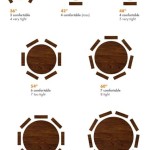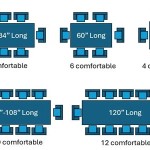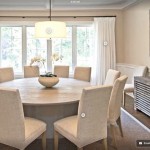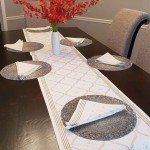Are Round Dining Tables Better For Small Spaces?
The selection of dining room furniture, particularly the dining table, represents a crucial decision impacting aesthetics, functionality, and the overall flow of a living space. In smaller homes and apartments, where space is a premium, the choice between a round and a rectangular dining table becomes especially significant. While rectangular tables remain a popular option, round tables are frequently touted as being more suitable for compact living environments. This article explores the arguments for and against this claim, delving into the various factors that influence the optimal dining table shape for limited spaces.
The perception that round dining tables excel in small spaces stems from several key characteristics. Firstly, their lack of sharp corners allows for easier navigation around the table, minimizing the risk of bumping into edges and creating a more fluid movement pattern within the room. This is particularly beneficial in tight quarters where every inch of space counts. Secondly, the circular shape often fosters a more intimate and conversational atmosphere, making it well-suited for smaller gatherings. However, a comprehensive evaluation requires a deeper examination of the specific advantages and disadvantages they present compared to their rectangular counterparts.
Space Efficiency and Traffic Flow
One of the primary reasons round tables are favored for small spaces is their perceived efficiency in optimizing traffic flow. Unlike rectangular tables, which can create bottlenecks in narrow rooms, round tables allow individuals to move around them more freely. The absence of corners means there are no sharp protrusions to navigate around, reducing the likelihood of accidental bumps and bruises. This is particularly important in apartments or homes where the dining area might also serve as a passageway to other rooms.
Furthermore, the circular form can visually make a room appear larger. The eye perceives the unbroken line of the circle as less intrusive than the hard lines of a rectangle. This visual trick can create a sense of openness, contributing to a more comfortable and less claustrophobic environment. However, the actual space occupied by a round table versus a rectangular table of similar seating capacity can be surprisingly comparable.
The key consideration here is the diameter of the round table in relation to the room's dimensions. A large round table, even without corners, can overwhelm a small space and impede movement just as effectively as a large rectangular table. Careful measurements and consideration of the surrounding furniture are essential to determine whether a round table truly offers a more efficient use of space.
Seating Capacity and Flexibility
While round tables often excel in creating an intimate dining experience, their seating capacity can be a limiting factor. A round table can typically accommodate fewer people than a rectangular table of the same surface area. This is because the perimeter of a circle is shorter than the perimeter of a rectangle with equal area. In practical terms, this means fewer chairs can comfortably fit around a round table.
However, the inherent egalitarian nature of the round table can be advantageous in specific scenarios. Without a designated "head" of the table, everyone has equal viewing angles and contributes to a more inclusive conversation. This can be particularly desirable for smaller gatherings and informal meals. But for those who frequently host larger dinner parties, the limited seating capacity of a round table could present a significant drawback.
The flexibility of seating arrangements is another consideration. Rectangular tables can be easily extended with leaves to accommodate more guests. Round tables, while extendable models exist, often require more complex mechanisms and can result in an awkward, non-circular shape when fully extended. Therefore, the potential for adaptability should be carefully evaluated based on individual entertaining habits and needs.
Aesthetic Considerations and Room Layout
The aesthetic appeal of a round table and its integration into the overall room layout significantly impact the perception of space. A round table can introduce a sense of softness and fluidity into a room dominated by straight lines, such as walls and other rectangular furniture pieces. This contrast can create a more visually appealing and harmonious environment.
However, the placement of a round table within a room requires careful planning. Round tables tend to work best when centered in a square or relatively symmetrical space. Placing a round table against a wall can look awkward and detract from its visual appeal. In contrast, rectangular tables can be easily pushed against a wall to maximize space in a narrow room, a flexibility that round tables lack.
The choice of table materials and design also plays a crucial role. A light-colored, minimalist round table can contribute to a sense of airiness and spaciousness, while a dark, heavily ornamented round table can feel bulky and overwhelming in a small room. Therefore, the visual weight and style of the chosen table should complement the existing decor and the overall aesthetic of the space.
Ultimately, determining whether a round dining table is a superior choice for a small space depends on a complex interplay of factors. The size and shape of the room, the number of occupants, the frequency of entertaining, and personal aesthetic preferences all contribute to the ideal solution. A careful assessment of these factors will ultimately guide the decision-making process and lead to a dining room setup that optimizes both space and functionality.
Furthermore, consider the style of the home. A modern, minimalist apartment might benefit from the clean lines and space-saving advantages of a round table, while a traditionally styled home might find a rectangular table more in keeping with the overall aesthetic. The finish of the table should also complement the flooring and other furniture in the room. A light wood or glass-topped table can help to create a sense of openness, while a dark wood table can feel more grounding and substantial.
In addition to the table itself, the choice of chairs is also important. Chairs with a low back and a simple design will take up less visual space than chairs with a high back and ornate details. It is also important to consider the spacing between the chairs and the table. Too much space can make the room feel disjointed, while too little space can make it difficult to move around the table. A general rule of thumb is to allow at least 24 inches of space between the edge of the table and the wall or other furniture.
Finally, remember that the best way to determine whether a round dining table is right for a particular space is to experiment. Use masking tape to outline the dimensions of both a round and a rectangular table on the floor, and then rearrange the furniture to see which shape works best. This will give a better sense of how the table will fit into the room and how it will affect the flow of traffic. Consider borrowing or renting a sample table, if feasible, for a more accurate assessment.

Why You Should Love Round Dining Tables And Top Picks From

The Best Dining Table Shapes Castlery Singapore

13 Best Small Space Kitchen And Dining Tables Of 2024 Top Picks

Why Round Dining Table May Work In Your Space 31 Examples

So What Is The Best Shape Of Dining Table For A Small Space First You Need To Round Rectangle Kitchen

How To Choose The Perfect Dining Table For Your Home Decoist

Rules Of Thumb For Rugs Under Round Dining Tables Inspiration

Small Space Dining Table At Home With Ashley

13 Small Dining Room Ideas And Decorating Tricks

Small Space Dining Table At Home With Ashley
Related Posts








